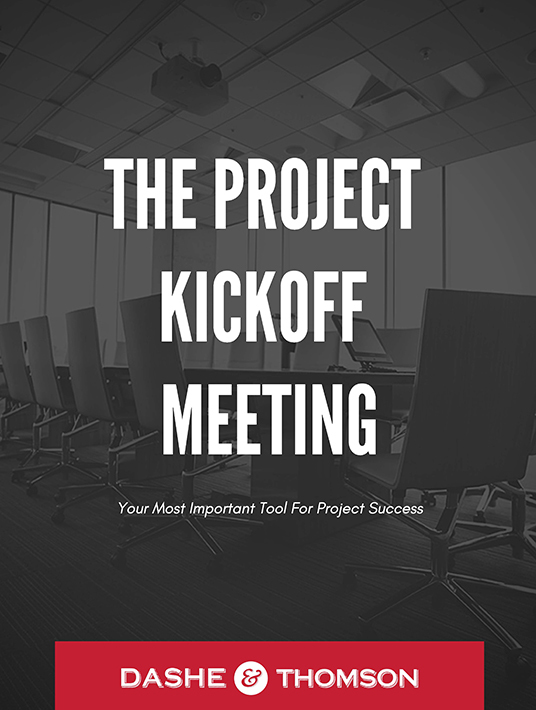Why A Project Kickoff Meeting Is Your Most Important Tool For Success
It is an essential tool to get a project started with the whole team invested and contributing to the project’s success right from the start.

After many years of running Learning & Development projects, we’ve developed a tried-and-true agenda to do just that. This simple, yet robust, kickoff meeting process and agenda ensures everyone is engaged, understands the project goals, scope, and risks, and actively takes responsibility for their roles.
A standalone kickoff meeting, however, is not enough. We know from experience that you cannot just show up—even if you have a tried-and-true agenda. A successful L&D project kickoff requires planning, which is best accomplished with pre-kickoff meetings and a rock-star project manager.
What follows is our two-step kickoff process and our Kick-A** Project Kickoff Agenda.
Step 1: Hold Two Pre-Kickoff Meetings
Yes, two!
We always hold two pre-kickoff meetings: one with the client’s project sponsor or manager and one with our internal team.
The purpose of meeting with the client’s project sponsor is three-fold:
- Review the agenda and customize, as necessary
- Align on specific kickoff meeting goals
- Uncover any potential roadblocks or circumstances that might interfere with achieving the kickoff meeting goals and discuss mitigation techniques
Immediately after meeting with the client, we send the agenda to all attendees, so they know what to expect and can plan accordingly.
Equally important as the client pre-kickoff meeting is our internal team pre-kickoff meeting. During this meeting, we run through the kickoff agenda to ensure everyone on our team understands the project scope and his or her role before showing up for the client kickoff meeting.
Step 2: Run The Kickoff Meeting Using This Kick-A** Kick-Off Meeting Agenda
Here's a breakdown:
Welcome & Introductions
We find that, if prepped in advance, the most influential welcome comes from the project sponsor, who is in the best position to share his or her vision for the project and emphasize how the project aligns with company goals.
After a brief welcome, we have the team share introductions—in an interactive and engaging way. Our goal is to set the stage for open, honest dialogue, not a lecture.
Project Goals & Scope Discussion (Walk Through The Statement Of Work)
Projects run way better when the people actually doing the work have a shared vision and wrestle with the details together. Our goal is to involve everyone in discovering and buying into what they need to do to make the project a success.
A key rule here is to never assume the team has read the statement of work. After introductions, we dive right into reviewing the project statement of work. Everyone gets a copy. This gives the team a clear idea on project goals and what the team is expected to produce and when.
- Goals
There are three important questions we must answer for the team. What is the project about? Why is this project important to the company or organization? How is the team going to get it done successfully? Ideally, the project sponsor has addressed the first two questions in the Welcome. At this point, we discuss and reinforce those goals and address the details related to how we’re going to get it done.
- Stakeholder definition
This is our opportunity to learn from the client about the stakeholders who will be affected by the project’s objectives. This is a great way to uncover—early in the project—stakeholder expectations, interests, concerns, and areas for quick wins.
- Deliverables
Reviewing a clear list of deliverables makes it much easier for the team to understand their roles and responsibilities and envision when the deliverables are due based on the milestone schedule that we present next.
- Milestone schedule
Reviewing a high-level milestone schedule helps everyone begin to see clear interim and long-term project goals.
- In/Out of scope
Here is where we often discover that there are a few team members who have not read the statement of work on their own. By carefully reviewing the project scope during the kickoff meeting, we can set (or reset) expectations now rather than when we’ve completed a good share of the work.
- Assumptions
In our experience, there are even more project members who have not read the assumptions. During the kickoff meeting, we read aloud all the assumptions listed in the statement of work and discuss in detail, if necessary. Again, if we’re are going to have any surprises, we want to know them now instead of partway through the project.
Methods And Process Discussion
The key outcome here is to set expectations regarding methods, processes and handoffs, roles and responsibilities.
We take this opportunity to educate the team and align on Instructional Design methods, key learning principles, and creative direction, including key elements like branding, look-and-feel, voice-and-tone, and Graphic Design. If time allows, we love to do some creative brainstorming and prototyping with the team and walk through existing content.
This is also the time when we outline the step-by-step development process—including the review and approval process—and ensure each team member clearly understands his or her role. We want to ensure that communication issues and late deliverables do not quickly become the only conversation in regular status meetings and that teams aren’t stepping on one another’s toes or unknowingly letting tasks fall through the cracks.
What Success Looks Like Discussion (Project Pre-Mortem)
Projects fail at a spectacular rate. One reason is that too many people are reluctant to speak up about their reservations.
Research, conducted by Deborah J. Mitchell, Jay Russo, and Nancy Pennington, found that prospective hindsight—imagining that an event has already occurred—increases the ability to accurately identify reasons for future outcomes by 30%.
Our “What Success Looks Like?” question is designed to get a clear idea of what project success really means, especially to the people who will approve the work. By making it safe to speak up, especially for dissenters, we can improve a project’s chances of success.
We use the pre-mortem approach to help project teams identify risks at the outset and, ultimately, head off any need for a painful postmortem.
Project Team Communication Plan Walk-Through
A strong communication plan facilitates regular communication between all levels of the project team, stakeholders, and project sponsors. At this point in the kickoff meeting, we discuss the project communications plan, clearly outlining the following:
- What is to be communicated? (status, issues, etc.)
- To who it should be communicated? (sponsors, Team Member(s), etc.)
- How often should the communication occur? (daily, weekly, monthly, etc.)
- What mediums will be used for communication? (project portal, email, standup meeting, etc.)
- Who is responsible to see that the communication meets the expectations above?
Wrap-Up
At the conclusion of all kickoff meetings, we review action items to ensure that each responsible party understands his or her action and is prepared to deliver to the specified timeline. We also ensure that we’ve addressed all the important items people brought up in the introductions and throughout the kickoff meeting.
In Conclusion
A successful project kickoff meeting sets the stage for the entire project. Read all about it in Dashe & Thomson's eBook: "The Project Kickoff Meeting: Your Most Important Tool For Project Success" Nailing the kickoff means our teams hit the ground motivated, engaged, and focused… and that the project sponsor and key stakeholders have confirmation that the team is ready to go.
Originally published at www.dashe.com.

